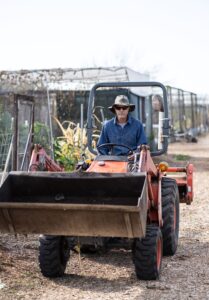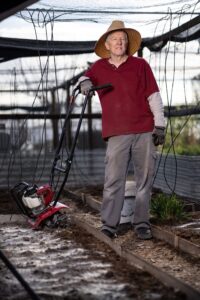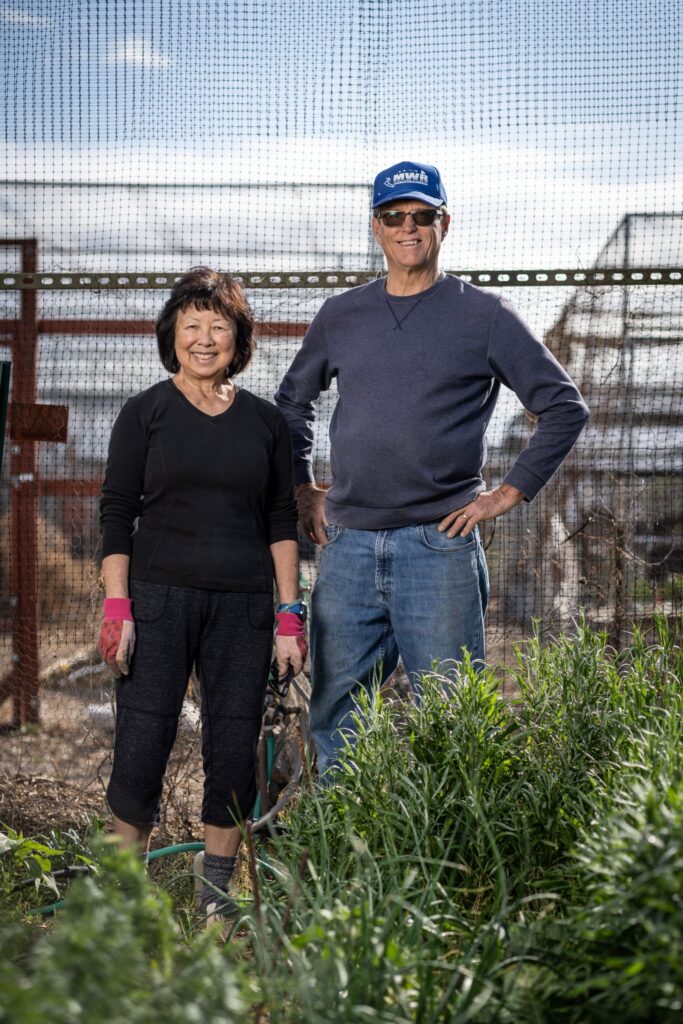Writer Joseph J. Airdo // Photography by Carl Schultz
Over the course of its nearly 50 years in existence, the Scottsdale Community Garden Club has seen a lot of interest from people who aspire to grow their own vegetables but may otherwise lack their own space or equipment to do so.
That interest increased exponentially in the spring of 2020 when, faced with the COVID-19 pandemic, people began looking for outdoor recreation options through which they could safely continue to actively engage their minds and bodies. It just so happens that gardening offers a whole slew of other benefits as well.
Gardening has been proven to burn calories, build strength, relieve stress, improve memory, increase confidence, foster connections and, of course, encourage healthier eating habits.
“I think that a lot of people are now focused on eating healthier,” says Paul Wright, vice president of the Scottsdale Community Garden Club. “Growing your own food is a fantastic way to eliminate any kind of processing or middleman playing with your food before it gets from where it was grown to where you are going to eat it.”
Established in 1976 by former Scottsdale resident Mark Miller, the Scottsdale Community Garden Club occupies about seven acres at the northeast corner of the Scottsdale Community College campus. More than 200 garden members and co-gardeners bring 186 plots to life with green lettuce, red tomatoes, yellow squash, white cauliflower and everything in between.
The nonprofit organization offers gardening experience for everyone from the novice beginner to the master gardener. The club provides water, wheelbarrows, soil amendments and tillers and its members provide a sense of community, camaraderie and experimentation.
Planting the Seeds



“I have been an amateur vegetable gardener for most of my life,” Wright says. “I grew up on the East Coast in New England and used to grow tomatoes with my father in the summertime. I moved to Arizona in the 70s and started to garden in my own backyard. In the 80s, I moved to a new home and kind of lost the time and space to do that.”
Wright’s friend eventually suggested that he join the Scottsdale Community Garden Club and he did so in 2008. He eventually served as the club’s president for four years before handing the baton over to Ron Lange, who developed an interest in gardening while growing up in Texas.
Lange moved to Arizona 38 years ago and, all the while, maintained gardening as a hobby. He, like Wright, learned about the Scottsdale Community Garden Club through a friend about eight years ago and jumped at the opportunity to join it — primarily because it would allow him to be in the company of others who shared his interest.
“It is a community yet, at the same time, we each have our own little canvas,” Lange says. “And we can put whatever we want in there. For anybody who has got garden interest, the club has done a phenomenal job at organizing a very affordable way to garden.”
In addition to all of the space and tools they need to be successful, members have access to the limitless resource that is their fellow gardener.
“There are some folks in the club who are master gardeners,” Lange says. “They can tell you everything you ever wanted to know about gardening.”
Wright adds that he often asks for advice from those with neighboring plots and other Scottsdale Community Garden Club members who have visible success with one vegetable or another.
“Our charter is education,” he explains. “What we are doing at our club meetings and just on a day-to-day basis is sharing our knowledge and our practices with one another so that everybody is doing a better job of growing vegetables.”
Nurturing the Growth



Wright adds that the makeup of the Scottsdale Community Garden Club’s membership is a reflection of Arizona’s population as a whole.
“I think that the diversity of the club’s membership has become extraordinarily unique compared to what it was 12 or 15 years ago,” he explains. “It reflects the Valley in that we have a lot of residents in Maricopa County who come from all kinds of places. We have folks from different parts of the country and even other countries around the world who have moved to Phoenix and want to grow their own food. The changing membership has been fun to watch.”
Moreover, the club sees gardeners of all ages getting their hands dirty in the soil — everyone from families with young children to retirees, each of whom works their plots during different times of the day.
“We are full and we have been for the past five years,” Wright says. “We have a waiting list that currently stands at somewhere around 20 or 30 people.”
Wright adds that, in recent years, the club has increased its engagement with Scottsdale Community College.
“We have a plot that is dedicated to the folks in the school’s culinary program,” he says. “The club also provides a scholarship that is awarded annually to a student in the culinary program. It essentially covers their tuition and fees for a year.”
At one point, the Scottsdale Community Garden Club attempted to coordinate harvests and donate vegetables to the school but its regimented curriculum made that a bit too difficult to accomplish. In lieu of that, the club has begun making donations twice a year — once during the holidays and once in the spring — to the food insecure on campus and in the greater community.
“Come November and December, everyone has got broccoli to burn, so to speak,” Wright says. “So when the crops are really coming in, we have, for the past several years, made donations to charities in the Valley such as Andre House, which is a nonprofit organization in Phoenix that focuses on folks who need a meal.”
Most recently, the Scottsdale Community Garden Club and Scottsdale Community College have joined forces to create pollinator pathways — pesticide-free corridors both in the garden and on campus of native plants that provide nutrition and habitat for pollinating insects and birds.
Harvesting the Crop



Having recently become a grandfather, Lange takes particular pride in being able to share his harvest with his daughter, who feeds the vegetables to her son in a pureed state.
He says that although there are some vegetables — such as onions and garlic— that cross growing seasons, one of the most important things that aspiring gardeners need to familiarize themselves with is the specific timing that they should plant each type of vegetable.
“One of the things that have become really clear to me since joining the Scottsdale Community Garden Club is what you should plant when,” says Lange, cautioning that the availability of plants at home improvement stores is generally not a very good guide. “But Arizona is an absolutely fun place to have a garden because you actually have two growing seasons.”
The fall/winter season is especially good for growing broccoli, cauliflower, beets, lettuces and peas while spring/summer planting is ideal for tomatoes, sweet corn, carrots, squashes, potatoes and peppers.
Wright adds that aspiring gardeners need only spend a little time researching local resources, like those available on the club’s website, and they will be shocked at just how much food they can grow on even a very small amount of land. He suggests starting with the soil itself.
“The native soil in Arizona is not like the soil in most of America,” Wright says. “Where I grew up in New England, you could just throw tomato seeds on the ground and you would get tomatoes. But our soils tend to be pretty clay-like. They need to be amended with some acid and compost.”
Ultimately, it is all about experimentation — something that the Scottsdale Community Garden Club facilitates even better than in your own backyard thanks to its communal atmosphere.
“Certain types of tomatoes do fantastic here in the Valley while others do not,” Wright says. “If you have never had romanesco, go ahead and try to grow it. If you have never grown your own Brussels sprouts and you like Brussels sprouts, go ahead give it a shot. The Scottsdale Community Garden Club allows folks to indulge in their own particular fantasy.”







Comments by Admin